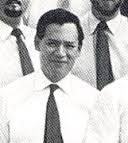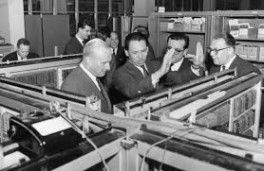Unsung Chinese engineer behind first desktop
Exactly 50 years ago, Mario Tchou, a brilliant Chinese electronic engineer and the head of Olivetti’s research centre in Italy, died in a tragic car crash.
In the English-speaking world, he is virtually unknown. Books on the history of the computer rarely mention him. Yet he was one of the great computer pioneers of the 20th century. In Italy, his name is remembered and revered to this day. At a time when China is experiencing a cultural and scientific renaissance, it is all the more important his legacy be preserved.
A Chinese-Italian, Tchou pioneered the use of transistors and built one of the world’s first mainframe computers with them. He also led a team that created the world’s first desktop.
His father was Tchou Yin, a Chinese diplomat in Rome, whose wife, Evelyn Wang, joined him in 1921. Mario Tchou was born in 1924. His mother was a liberated woman who campaigned for women’s rights, especially in China.
Tchou was a brilliant and popular student. His parents’ house in Rome was open to the children of prominent Romans, and some still remember the courtyard of the Chinese embassy as an ideal place to play football. Having graduated in engineering in 1945 and won a scholarship, Tchou was sent to the United States.
While there, he met Mariangela Siracusa, an Italian student at Columbia University, and soon married her. By 1952 he was already an assistant professor at Columbia in electrical engineering and a director of the prestigious Marcellus Hartley Laboratory. He was working under John R.Ragazzini, who during the second world war contributed to the development of analogue calculators and control systems.
In 1954, Tchou had a fateful encounter with Adriano Olivetti, the owner of the Olivetti Company, a visionary industrialist and intellectual. The two were similar in personality and it was love at first sight. The industrialist convinced Mario to return to Italy, where he was put in charge of a team creating a commercial computer and provided with funds.
The crack team of engineers was all Italian, except for Martin Friedman, a Canadian. Sandro Sartor was part of the group of 50 engineers and still remembers Tchou
‘He was the most intelligent man I have ever met in my life, and he was so good to keep together that bunch of eccentric young boys.’
In September 1957, the team created the first prototype, called the Zero, a name later changed to Elea 9001. It used valves, or vacuum tubes. At that time, Tchou decided an important change of direction: their next computer would have no valves. One of his engineers, Giorgio Sacerdoti, remembers that day: ‘The decision was taken during an urgent meeting called by Tchou on a Sunday afternoon in 1957.
‘The transistors at that time were something seen only in laboratories, and their use was extremely risky. The switch could mean a delay of one year. All of this was clearly spelled out by Tchou during his introduction, when he told us that he had decided to go for it. His decision shows that he could see far and wide into the future.’
Transistors were not easily available on the market, and they could not find enough of them in Europe. Because of this, Olivetti founded a new company to produce them. It is still operating under the name STMicroelectronics.
It was at this time that his first marriage ended in a separation. He had entered into a new relationship with a young painter, Elisa Montessori, and she would give him two daughters. The new computer was nearly ready when they decided to move to a new location, at Borgo Lombardo, near Milan. From 50 people, Tchou now had to manage 500 engineers.
The new computer was called Elea 9003. Its memory storage was as large as a tennis court and its console had the dimensions of a Coca Cola vending machine. In spite of its great size, the design was very attractive and built following a modular plan. It was the work of a young and then not-very-well known industrial designer, Ettore Sotsass. The computer beat IBM’s first fully transistorised mainframe computer by several months.
In spite of the high cost, the performance of the machine was impressive for the time, and about 35 large companies placed orders. One of those units is still working today at a technical institute in Italy: students can physically enter its memory, like in the movie Tron. In 1960 they were working on a new computer, less powerful but cheaper; the result would be the Elea 6001. Between 1961 and 1965 more than 100 units were sold to universities and laboratories.
At the beginning of 1960, Olivetti had a fatal stroke in a train compartment. He was 59 years old. Tchou died in 1961, before the presentation of the Elea 6001. But his team of engineers – led by Tchou’s right-hand man, Piergiorgio Perotto – went on to produce a smaller, more powerful model. It would prove to be the first real desktop computer.
It was called Programma 101, and when it was presented at an exhibition in New York in 1965, it caused a sensation, with The New York Times and The Wall Street Journal giving it front-page coverage.
Hewlett-Packard bought 100 units, and soon after it went on the market with a similar model. The Olivetti firm sued and won, but without Tchou and Olivetti, they had lost the edge. Bankers made it a condition for new loans that their electronics division be sold to General Electric. That was the end of Tchou’s dream.
Angelo Paratico



